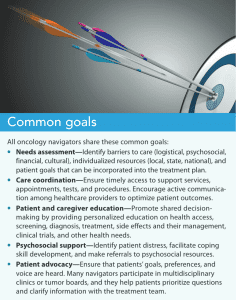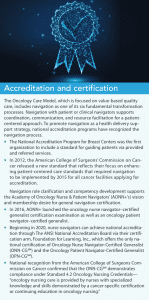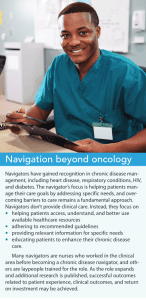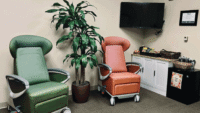Nurse navigators help avoid care fragmentation and support shared decision making.
Takeaways:
- Patient navigation aims to increase health equity among patients with cancer and can be applied in a variety of inpatient and outpatient settings.
- Navigators, members of the oncology interprofessional team, help address oncology care fragmentation and promote delivery of a coordinated and seamless experience across the care continuum.
- With ongoing evidence of positive patient experience, good clinical outcomes, and return on investment, navigation is integral to care quality in oncology and other chronic diseases.
Over the past 3 decades, cancer screening services and treatments have improved. However, as complex technologies flood the market, patients and caregivers face data overload and struggle to understand treatment. Patients may meet with each of their oncology providers one at a time, creating a silo effect, or they may have a multidisciplinary consultation where they see several providers at one appointment, which can make it challenging to absorb all the information provided. The patient also may experience a fragmented healthcare system within a single clinical setting or between clinics in different locations. Oncology navigation can address this fragmentation, help explain the maze of information, and enhance shared decision making.
Several organizations—including the Com-]mission on Cancer (CoC), American Cancer Society (ACS), Academy of Oncology Nurse & Patient Navigators (AONN+), and Oncology Nursing Society (ONS)—recognize the importance of the navigation care approach and its role in increasing health equity among patients with cancer. Oncology navigators practice in a variety of settings, including healthcare systems, specialty practices such as urology and gynecology, and community agencies.
Evolution of oncology navigation
The roots of this profession begin with the 1989 findings of the ACS National Hearings on Cancer, which revealed that individuals in lower-income U.S. populations endure greater pain and suffering from cancer than those in higher-income populations. In response to that report, Harold P. Freeman, MD, founded the Harlem Cancer Education and DemonstrationProject to develop and pilot a navigation program that included culturally sensitive education for public outreach and access to screening services in his predominantly poor urban Black community. This navigator model used nonclinical licensed staff (patient navigators) who focus on reducing health disparities. The pilot program showed improvements in 5-year breast cancer survival rates from 39% (pre-navigation) to 70% (after introducing navigation). Oncology navigator programs grew nationwide, with funding from sources such as the National Cancer Institute, ACS, Avon Foundation, Susan G. Komen, and federal government agencies. Most of the funding supported patient navigators who had direct knowledge of the community and its resources. After training provided by the health system employer, the navigators helped patients overcome barriers to ensure prompt diagnosis and treatment, enroll in clinical trials, and explore insurance coverage options.


At the same time, the nurse navigator role evolved as healthcare systems focused on patient-centered care. It advanced through oncology utilization review, utilization management, and case management to the point where nurses experienced in oncology worked with multidisciplinary healthcare teams to improve efficiency and adherence to care by linking patients with hospital or community resources.
In the early 2000s, as most oncology care moved to the outpatient setting, nurse navigation progressed to this setting with emphasis on care and transition coordination using community resource outreach. Breast cancer navigation became a primary patient population focus of nurse navigation when Lillie Shockney, MAS, BS, RN, publicized her success at the Johns Hopkins Hospital in Baltimore, Maryland, where she helped increase appointment completions, improve timeliness of care, and expedite chemotherapy start time by 2 weeks.
Clinical and nonclinical navigators now work as members of multidisciplinary teams through-out a patient’s care continuum and are viewed as a central point of contact who acts on behalf of the patient. The navigation process has a bidimensional care concept—patient-centered to ensure continuity of care by promoting patient empowerment and integrated psychosocial care across disciplines and the health system—which focuses on improving access to medical care and decreasing setting fragmentation.
Navigation goals
No single standardized oncology navigation process can meet the needs of diverse populations in distinctive settings across the cancer continuum. Different models of navigation—including those that are care-continuum specific (only community outreach, screening, diagnostics, treatment, or survivorship), longitudinal (from diagnosis through survivorship with the same navigator), disease-specific (solely one disease such as breast, thoracic, or GI), general (all oncology patients), or financial (reduce hardship related to treatment cost)—have been created to meet the needs of unique populations and settings. Roles and activities fulfilled by oncology navigators may vary given their professional background and work environment, but they all share common goals. (See Common goals.)
The navigator goals and activities comprise integral components of the Chronic Care Model. They promote productive interactions between educated patients and a proactive practice team for improved outcomes. The basis of this model highlights care coordination within and across three overlapping domains—the entire community, healthcare systems, and provider organizations—in which the navigator promotes shared decision making. The navigator works within and promotes the model’s six elements of community resources—healthcare system, patient self-management, decision support, delivery system redesign, and clinical information systems—to facilitate interprofessional collaboration, ensure quality care delivery, promote patient satisfaction, and effectively use resources to promote value-based care.
Role delineation and competencies
As the navigation profession evolved, so did the competencies and role functions used to describe the navigator types within the oncology care team. The patient navigator isn’t clinically licensed but is trained to provide individualized assistance to patients and families affected by cancer to improve healthcare service access. Programs such as the George Washington Cancer Center’s Oncology Patient Navigator Training: The Fundamentals, the Patient Navigation Training Collaborative, and AONN+ are used to prepare these navigators. Clinically licensed navigators, such as nurses and social workers, navigate within the scope of their practice and have training opportunities through ONS and AONN+.
The current patient navigator competencies are reflected in the Patient Navigation Framework published by the George Washington University Cancer Institute team and consists of 12 functional navigation domains: professional roles and responsibilities, community resources, patient empowerment, communication, barriers to care/health disparities, education/prevention and health promotion, ethics and professional conduct, cultural competency, outreach, care coordination, psychosocial support services/assessment, and advocacy. ONS published Oncology Nurse Navigator Core Competencies, which include four functional areas of the professional role: education, coordination of care, communication, and professional role. ONS also defines an expert oncology nurse navigator (ONN) with 12 core competencies.
AONN+ created eight knowledge domains that differ from ONS competencies with an emphasis on community outreach and prevention (focusing on population health, community needs assessment, and risk reduction), operations management (focusing on organizational structure, mission, and vision), development and healthcare economics for patient optimization in healthcare, and quality and performance improvement (promoting metrics that measure and create processes to enhance value in evidence-based navigation practices). (See Accreditation and certification.)


Metrics
With the shift to value-based care, the navigation profession moved to promote metrics as an avenue for sustaining the role. Early in the profession’s development, published results demonstrated that navigation could increase participation in cancer screening, promote adherence to diagnostic follow-up care, provide health education about cancer across the continuum, increase clinical trial knowledge and participation, address patient barriers to care, and provide psychosocial support to populations most at risk for poor outcomes. The AONN+ Evidence into Practice Metrics Committee created 35 evidenced-based national navigation metrics that any program can use in their navigation model. The metrics fall into the categories of patient experience, clinical outcomes, and return on investment. The committee developed a crosswalk by taking the standardized metrics and demonstrating how they align with the national standards and indicators from CoC, the National Accreditation Program for Breast Cancers, OCM, the Quality Oncology Practice Initiative, and the Medicare Access and CHIP Reauthorization Act.
With the support of ACS, a national standardized toolkit for validating measures and demonstrating the impact of any oncology navigation model was finalized. This how-to guide on metric selection, implementation, reporting, and quality strategy improvements can be applied to daily care in new or mature navigation programs.
Improving outcomes
As members of the oncology interdisciplinary team, navigators help address care fragmentation and promote delivery of a coordinated and seamless patient experience across the care continuum. This role also aids in improving the clinical processes and financial outcomes for the settings where they work. Ongoing evidence supports the navigator’s value in oncology and other chronic disease care. (See Navigation beyond oncology.)


Sharon Gentry is program director for the Academy of Oncology Nurse and Patient Navigators in Cranbury, New Jersey. She has received navigation presentation sponsorship from Pfizer.
References
Academy of Oncology Nurse & Patient Navigators. ANAB awards national accreditation to AONN+ Foundations for Learning, Inc. August 5, 2020. aonnonline.org/press/3068-anab-awards-national-accreditation-to-aonn-foundations-for-learning-inc
Academy of Oncology Nurse & Patient Navigator. Certification. aonnffl.org
Academy of Oncology Nurse & Patient Navigators. Navigation metrics. August 2020. aonnonline.org/navigation-metrics
Gentry S. Breast navigation. In: Mahon S, ed. Guide to Breast Care For Oncology Nurses. Pittsburgh, PA: Oncology Nursing Society; 2018.
Kaiser Permanente. The Chronic Care Model. improvingchroniccare.org/index.php?p=The_Chronic_Care_Model&s=2
McBrien KA, Ivers N, Barnieh L, et al. Patient navigators for people with chronic disease: A systematic review. PLoS ONE. 2018;13(2):e0191980. doi:10.1371/journal.pone.0191980
Oncology Nursing Society. 2017 Oncology Nurse Navigator Core Competencies. 2017. ons.org/sites/default/files/2017-05/2017_Oncology_Nurse_Navigator_Competencies.pdf
Patel M. The Oncology Care Model: Aligning financial incentives to improve outcomes. Oncology Practice Management. 2016;6(12). bit.ly/3qprq68
Pratt-Chapman M, Burhansstipanov L. Navigation training, tools, and resources. In: Shockney L. D. ed. Team-Based Oncology Care: The Pivotal Role of Oncology Navigation. Cham, Switzerland: Springer International Publishing; 2018.

















